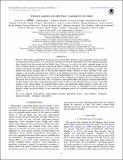SURFACE ALBEDO AND SPECTRAL VARIABILITY OF CERES
Author(s)
Li (李荐扬), Jian-Yang; Reddy, Vishnu; Nathues, Andreas; Corre, Lucille Le; Izawa, Matthew R. M.; Cloutis, Edward A.; Sykes, Mark V.; Carsenty, Uri; Castillo-Rogez, Julie C.; Hoffmann, Martin; Jaumann, Ralf; Krohn, Katrin; Mottola, Stefano; Prettyman, Thomas H.; Schaefer, Michael; Schenk, Paul; Schröder, Stefan E.; Williams, David A.; Smith, David E.; Konopliv, Alexander S.; Park, Ryan S.; Raymond, Carol A.; Russell, Christopher T.; Zuber, Maria; ... Show more Show less
DownloadLi-2016-SURFACE ALBEDO AND S.pdf (889.3Kb)
PUBLISHER_POLICY
Publisher Policy
Article is made available in accordance with the publisher's policy and may be subject to US copyright law. Please refer to the publisher's site for terms of use.
Terms of use
Metadata
Show full item recordAbstract
Previous observations suggested that Ceres has active, but possibly sporadic, water outgassing as well as possibly varying spectral characteristics over a timescale of months. We used all available data of Ceres collected in the past three decades from the ground and the Hubble Space Telescope, as well as the newly acquired images by the Dawn Framing Camera, to search for spectral and albedo variability on Ceres, on both a global scale and in local regions, particularly the bright spots inside the Occator crater, over timescales of a few months to decades. Our analysis has placed an upper limit on the possible temporal albedo variation on Ceres. Sporadic water vapor venting, or any possibly ongoing activity on Ceres, is not significant enough to change the albedo or the area of the bright features in the Occator crater by >15%, or the global albedo by >3% over the various timescales that we searched. Recently reported spectral slope variations can be explained by changing Sun–Ceres–Earth geometry. The active area on Ceres is less than 1 km[superscript 2], too small to cause global albedo and spectral variations detectable in our data. Impact ejecta due to impacting projectiles of tens of meters in size like those known to cause observable changes to the surface albedo on Asteroid Scheila cannot cause detectable albedo change on Ceres due to its relatively large size and strong gravity. The water vapor activity on Ceres is independent of Ceres' heliocentric distance, ruling out the possibility of the comet-like sublimation process as a possible mechanism driving the activity.
Date issued
2016-01Department
Massachusetts Institute of Technology. Department of Earth, Atmospheric, and Planetary SciencesJournal
Astrophysical Journal. Letters
Publisher
IOP Publishing
Citation
Li (李荐扬), Jian-Yang et al. “SURFACE ALBEDO AND SPECTRAL VARIABILITY OF CERES.” The Astrophysical Journal 817.2 (2016): L22. © 2016 The American Astronomical Society
Version: Final published version
ISSN
2041-8213
2041-8205
